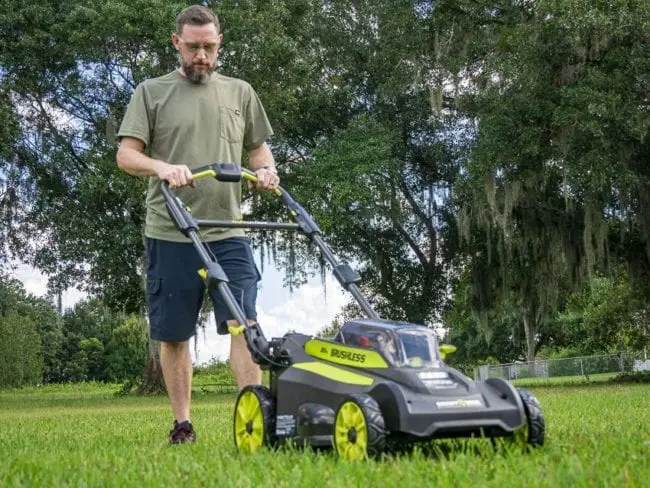Ryobi Smart Trek 20″ Lawn Mower Highlighted by Value and Quiet Operation
We tested 24 mowers for a head-to-head comparison recently, looking at both gas-powered and battery-powered models. We even considered commercial mowers and mowers geared more toward homeowners. Ryobi sent 2 versions of their latest mower. Today’s muse if the Ryobi Smart Trek 20″ self-propelled lawn mower. There’s also a 21″ version that you can read about here.
Pros
- Single-point height adjustment
- Quiet operation at 80 dB(A)
- Efficient battery use
- High value score ($449 kit with 6.0Ah battery)
Cons
- Self-propelled drive takes time to adjust to
- Competent to cut, but less power than some of its competition
Shootout Results
The Ryobi Smart Trek 20″ self-propelled lawn mower does its best work if you generally keep up with your grass height consistently and place a heavy priority on bang for your buck and low noise. If that’s you and your house sits on a lot up to 1/3 of an acre, pull the trigger. Grab an extra battery to confidently cover 1/2 an acre.
We’re curious to see more feedback on the Smart Trek system and if Ryobi decides to make any adjustments to it moving forward. As the highlight feature for two of their battery-powered lawn mowers, it’s a big change from traditional drive systems that takes time to adjust to.
Battery-Powered Self-Propelled Lawn Mower Ranking: 9th Place
Performance
We use a complex variety of testing methods and data analysis to come up with our mower rankings, but we don’t necessarily want to bore you with the ins and outs of all that here. However, if that’s the sort of thing that gets you up in the morning, feel free to check out our cordless mower shootout!
Cutting Speed
Maintaining a fast blade tip speed is important for a mower since it ensures that it will provide the suction to pull the grass up into the deck and the power to actually cut.
We first measured the no-load speed of each mower to get a good baseline reading of what each one was capable of. This Ryobi Smart Trek 20″ self-propelled lawn mower clocked in at 2574 RPM with the blade tips hitting 145.4 MPH. This was the slowest no-load speed that we saw from our self-propelled battery-powered mowers.
With brushless motors, we expect an increase in speed as the mower encounters resistance. As the job gets tougher, a brushless motor’s electronics will direct more power to the blades to keep up with the work.
So, we hooked each mower up to our light-duty simulation – a test designed to replicate the conditions of a weekly maintenance cut. The Ryobi Smart Trek 20″ lawn mower actually dropped a bit of speed here. It only cranked out 2521 RPM with 142.4 MPH on the blade tips. That keeps it in last place at this point.
We then put our mowers through our heavy-duty testing, increasing the load we put on the blade. While we did see an increase of 19.5 MPH, this Ryobi model still finished in the last position with 2867 RPM and 162 MPH blade tip speed.
Takeaway
3000 RPM is the kind of rotation speed we like to see when we’re cutting to get the best mulching and bagging characteristics. However, that’s roughly 160 – 190 MPH a the blade tips depending on the blade diameter and Ryobi does hit the bottom of that range.
The trade-off here is that the lower speeds give you more efficient use of your battery while leaving a cut that isn’t as clean as models with higher speed and lift.
Cutting Area
Another important aspect of a battery-powered mower revolves around its runtime and power management. With a gas mower, you can just drop some more fuel into the tank and go. But with battery power, you get a nice long break if you run out of juice and don’t have a back-up battery charged up. Getting the most cutting area out of your battery is a big deal.
Under maintenance-cut conditions, we got 48 minutes worth of runtime from the Ryobi Smart Trek 20″ self-propelled lawn mower’s 6.0Ah battery. With its 19″ blade (yes, this “20-inch” mower uses a 19″ blade) and 48 minutes of runtime while walking at a constant 2.5 MPH, you can clear up to 16,720 square feet on a charge. To put in terms that are a little more concrete, that’s about 0.38 acres.
From a runtime perspective, it’s not bad at all. We like to see around 45 minutes at a minimum unless you’re maintaining a small city lot. Ryobi gives you plenty of maintenance cutting time for lawns up to 1/3 acre or so. You can easily do 1/2 an acre by adding a second battery.
Battery Efficiency
How efficient is Ryobi’s battery use? With its 40V, 6.0Ah battery, we’re looking at a grand total of 216 watt-hours. Under no-load, the Ryobi runs for 56 minutes, while under a light load, it runs for 48. This is 85.7% of the no-load speed, which is actually the highest percentage we saw.
Keeping in mind that its blade speeds were also the slowest on a maintenance cut, it’s clearly prioritizing efficiency.
With 16,720 square feet of cutting on a charge, we see that this mower gets 77 square feet mowed per watt-hour.
The end result? The Ryobi Smart Trek 20″ lawn mower finished our efficiency testing as the 2nd-place finisher behind the Greenworks Commercial model and virtually tied with Kobalt’s 80V.
Noise Level
With gas power, we just assume every mower will be loud (which is almost universally true, save for the Honda HRC216 mower we tested). Battery-powered mowers have the benefit of being a whole lot quieter to run, so we think it’s worth the comparison.
This Ryobi self-propelled lawn mower cranked out just 80 dB(A), which was good enough for a 5th-place finish in our shootout and just 2 decibels out of first place. In any case, your neighbors will appreciate your choice to go with the Ryobi if you’re getting to work early on Saturday morning.
Feature Set
Smart-Trek Drive
We like the idea of Ryobi’s Smart Trek drive, but it is a change that takes time to get used to. It works like this: as you walk forward, you sort of naturally press in on the spring-loaded handle. This is your throttle – the faster you walk, the more you’re pressing in on the handle and the faster the mower drives forward.
The struggle is that the drive kind of jumps forward or brakes hard. There’s no real easy transition from slow to fast or fast to slow, and the movement feels jerky. By bending your elbows, you learn to kind of roll with the changes the same way a mountain biker or skier tackles a course. There’s definitely an adjustment period, though.
Deck Material
We understand why some teams use plastic poly for the mower deck – generally, it drops some weight from the mower and makes it easier to push around. But we prefer steel for its durability. The Ryobi 20″ Smart Trek self-propelled lawn mower opts goes the plastic route.
Height Adjustment and Range
We really like the height adjustment design on this Ryobi Smart Trek lawn mower. It’s a single-point adjustment, but where other single-point adjustments can still require you to lift up while you adjust, this one really can be set one-handed without having to wrestle with it.
It has 7 available positions ranging from 1.75″ to 4.5″. There are some instances where you might like to get a bit lower on the bottom end of the range, but this mower will tackle the vast majority of grass types you’ll come across.
Handle Positions
Rather than having two or three set positions to set your handle, you can actually slide the handle to a position that feels most comfortable for you. #win.
Discharge Options
Out of the box, you can bag or mulch with the Ryobi 20″ Smart Trek self-propelled lawn mower, suiting the majority of situations. If you prefer the side discharge option, Ryobi offers the accessory separately.
Additional Features
- Easy lift release and lock bagging system
- Additional battery storage (inactive)
Value
With a 6.0Ah battery and charger, the Ryobi RY40LM30 kit runs $449 at Home Depot. It comes with a 5-year warranty on the mower as well. It scores well for value, thanks to a budget-friendly price to go with its adequate performance.
One of the reasons we like Ryobi tools so much is just because of the incredibly deep line they have. The 40V line doesn’t have the same depth as their One+ 18V line, but there’s still a lot to choose from. Ryobi has string trimmers, blowers, leaf vacs, snowblowers, cultivators, mowers, chainsaws, sprayers, hedge trimmers, pole saws, and a multi-head power system available on the 40V platform.
The Bottom Line
The Ryobi Smart Trek 20″k self-propelled lawn mower does its best work if you generally keep up with your grass height consistently and place a heavy priority on bang for your buck and low noise. If that’s you and your house sits on a lot up to 1/3 of an acre, pull the trigger. Grab an extra battery to confidently cover 1/2 an acre.
We’re curious to see more feedback on the Smart Trek system and if Ryobi decides to make any adjustments to it moving forward. As the highlight feature for two of their battery-powered lawn mowers, it’s a big change from traditional drive systems that takes time to adjust to.
Ryobi Smart Trek 20″ Self-Propelled Lawn Mower Specs
- Model Number: Ryobi RY40LM30
- Battery: 40V 6.0Ah
- Drive Type: Smart-Trek rear-wheel self-propelled
- Drive Speed: Variable, up to 2.9 MPH
- Deck Size: 20″
- Cut Height: 1.5″ – 4″
- Deck Height: 7-point
- Start Type: Push button
- Cutting Options: Mulching, bagging, and side-discharge
- Recommended Yard Size: Up to 1/2 acre (1/3 acre PTR recommendation)
- Weight: 45 lbs
- Warranty: 5-year limited
- Price: $449
For more information about Ryobi’s 40V lineup, check it out by clicking here.











